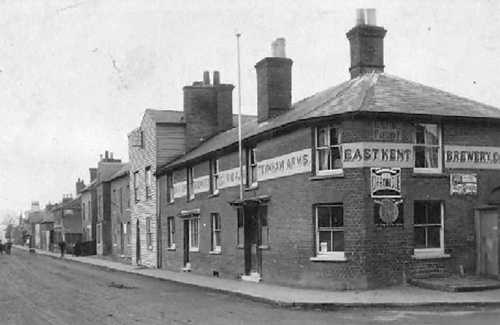Teynham's Last Post
At the end of the Great War, towns and villages across the country raised memorials to commemorate those that lost their lives. Teynham was no different and the roll of honour sits proudly on the wall of the south chapel in St Mary’s church. Unveiled in April 1920 by Lord Harris, the bronze plaques remembers 43 names associated with the village.
Most were native to Teynham and nearly all those named are laid to rest on foreign soil. All but three were serving members of the armed forces. The three civilians were all workers in the Uplees gunpowder factories on Luddenham Marsh.
Arthur Beesley (Beasley) [born 1881], of whom little slse is known, and Cornelius Taylor [Born 1891 Teynham, Kent. In 1911 he was a brickmaker, living with his parents at 15 Conyer Road, Teynham. William Taylor and Adelaide Amelia Sills [m. 1870 Chatham] Cornelius was one of 16 siblings.], a Conyer brick maker, in more peaceful times, both lost their lives in the worst explosive disaster in the UK. On Sunday 2nd April 1916, 115 men died at the Explosives Loading Company’s Marsh Works, when some 200 tonnes of TNT & Saltpetre exploded, causing a blast that could be heard as far away as Gt. Yarmouth. Had this happened on any other day of the week, there would sure to have been females amongst the numbers.
At start of the 1914 there were just 20,000 women employed in dockyards, factories and arsenals throughout the U.K., but with the men being conscripted, women were tasked with increasing production for the war effort. None more so than in the munitions industry, where the ‘munitionettes’ outnumbered the men. Not on that fateful Sunday, however, as women were still expected to be at home cooking Sunday dinner.
Work in the munitions industry was always a dangerous one and Faversham had seen its share of incidents since the 16th Century. An accident in 1847 producing the newly invented guncotton in Marsh Works had seen 18 people killed in an explosion. This was long before the Admiralty seconded the town explosives factories at the start of the Great War.
Workers were paid around 2/- extra ‘danger money’ each week and pay was double that of domestic servants at the time, usually for fewer hours. Still only half as much as any of the men they worked alongside.
The last name on the plaque is the only female, Alice Post.. Alice was born in January 1894, the second oldest of eight children, to James & Henrietta Post, Greenstreet's “Hairdresser, Perfumer, and Chimney Sweep” for over 30 years. Living between the Rose Inn and Teynham Arms in her early years, Alice, like two of her sisters journeyed to London to take up ‘service’ as a domestic at a an early age. With her sisters working in Tulse Hill, Alice was “General Housekeeper” to a small household in Battersea. Almost certainly, Alice left service and returned home to give birth to her daughter, Margaret Alice, in mid-July 1915.
Weeks later Pt. James (Jim) Wilson Barnett Lucas who had grown up with Alice, living just two doors away, was tragically drowned off Shakespeare Cliff, Folkestone after returning from two weeks home leave.
Pt Lucas is buried in the churchyard and also commemorated on the same plaque as Alice, in St Marys – aged19.
What took Alice to leave the baby so young, is purely speculative. Patriotic pride, the lack of a husband, or just the extra cost associated with the baby, we don’t know, but she began work at Marsh Works for Curtis & Harvey Ltd, in the last week of November. Workers like her were responsible for hand filling TNT mixture into shells and for the first couple of weeks Alice managed the long hours and the daily 10 mile walk across the marshes, despite the particularly wet winter that year. Workers would soon to be able to take the wooden wheeled light gauge railway from Davington direct to the Marsh Works gatehouse.
However after just a couple of weeks at work Alice started feeling unwell, complaining of tiredness and headaches. Things became so bad that she was unable to return to work after the 30th December 1915. Her health deteriorated rapidly and Alice died at 9.30pm on Sunday 16th January 1916 – just days before her 22nd birthday.
 At the inquest held at the Teynham Arms, a few doors from her home, on 20th January, Mr Charles Harris, coroner for Sittingbourne district, specified the cause of death as “Trinitrotoluol (TNT) poisoning - contracted in employment”. Alice was one of over 400 “Canaries” who died in the munitions industry during WW1. These Canary Girls, as they were popularly referred to, because of prolonged exposure to these hazardous chemicals that turned their skin yellow, played an influential part in the war effort producing around 80% of the ammunition used by the British Army during the first word war.
At the inquest held at the Teynham Arms, a few doors from her home, on 20th January, Mr Charles Harris, coroner for Sittingbourne district, specified the cause of death as “Trinitrotoluol (TNT) poisoning - contracted in employment”. Alice was one of over 400 “Canaries” who died in the munitions industry during WW1. These Canary Girls, as they were popularly referred to, because of prolonged exposure to these hazardous chemicals that turned their skin yellow, played an influential part in the war effort producing around 80% of the ammunition used by the British Army during the first word war.
Her headstone cannot be found in St Mary’s churchyard, but the inclusion of Alice on the roll of honour means that along with 42 others, Teynham will remember them.
Terry Shea